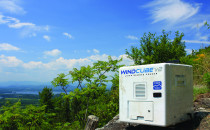
Despite the maturation and widespread use of Lidars in the wind energy industry, we continue to hear common misconceptions related to the technology. This list contains the 10 most common myths about wind Lidar and the true story behind them.


Despite the maturation and widespread use of Lidars in the wind energy industry, we continue to hear common misconceptions related to the technology. This list contains the 10 most common myths about wind Lidar and the true story behind them.

The nacelle-mounted Wind Iris Lidar is one of the most intriguing new technologies in the wind industry. But what, exactly, can it do?

Do you suspect that you have underperforming wind turbines? Are you familiar with the causes and consequences of yaw misalignment? In a recent webinar, we discussed one of wind farm owners’ biggest problems, turbine underperformance, and one of the industry’s most promising tools, nacelle-mounted Lidar.

First Wind recently purchased a Wind Iris Lidar to optimize the performance of its wind turbines. This decision was the result of a successful field trial that used data from the nacelle-mounted Lidar to increase the total energy production of a turbine.

I drive by a single white wind turbine nearly every day. Backdropped by rolling farm fields and the jagged summit of Mount Mansfield to the east, it is a dramatic sight—especially when a storm is approaching and the turbine is bright against heavy, hard metal clouds. I like to gauge the weather by watching its steady blades.

While most owners and operators consider a condition monitoring system’s initial price tag, many do not realize that the annual analysis costs can also be significant.
Every April as the ground thaws, the buds crack open, and the days grow longer, Earth Day arrives with its gentle reminder: “It’s the Planet, Stupid.
As the future of the U. S. wind industry grows less certain day by day, wind farm developers and equipment manufacturers will continue to announce workforce reductions in the US.
Inspired by Justin Wheating’s last post, I’m focusing this month on something we can control.
In an earlier blog post, I wrote about the return-on-investment of condition based maintenance (CBM) for wind turbines. For those who would like a primer on CBM and the value it provides, start there.